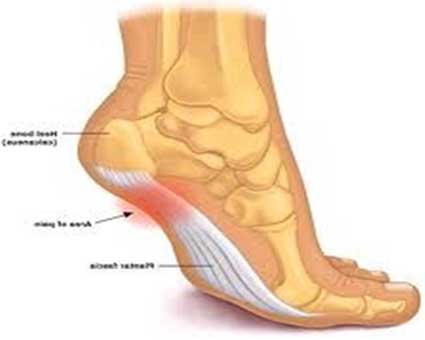
Plantar Fasciitis
 Plantar fasciitis is the most common cause of heel pain. The plantar fascia is the flat band of tissue (ligament) that connects heel bone to toes. It supports the arch of the foot.
Plantar fasciitis is the most common cause of heel pain. The plantar fascia is the flat band of tissue (ligament) that connects heel bone to toes. It supports the arch of the foot.
Cause -
1. When feet roll inward too much when you walk (excessive pronation )
2. When we walk, stand, or run for long periods of time, especially on hard surfaces
3. Tight Achilles tendons or calf muscles
Risk Factors -
Active - Sports that place excessive stress on the heel bone and attached tissue, especially if you have tight calf muscles or a stiff ankle from a previous ankle sprain, which limits ankle movement eg. Running, ballet dancing and aerobics.
Overweight - Carrying around extra weight increases the strain and stress on your plantar fascia.
Pregnant – The weight gain and swelling associated with pregnancy can cause ligaments to become more relaxed, which can lead to mechanical problems and inflammation.
On your feet – Having a job that requires a lot of walking or standing on hard surfaces i.e. factory workers, teachers and waitresses.
Flat Feet or High Foot Arches – Changes in the arch of your foot changes the shock absorption ability and can stretch and strain the plantar fascia, which then has to absorb the additional force.
Middle-Aged or Older – With aging the arch of your foot may begin to sag – putting extra stress on the plantar fascia.
Wearing shoes with poor support.
Weak Foot Arch Muscles- Muscle fatigue allows your plantar fascia to overstress and cause injury.
Arthritis- Some types of arthritis can cause inflammation in the tendons in the bottom of your foot, which may lead to plantar fasciitis.
Diabetes- Although doctors don't know why, plantar fasciitis occurs more often in people with diabetes.
Symptoms -
1. Pain on the bottom of the foot near the heel
2. Pain with the first few steps after getting out of bed in the morning, or after a long period of rest, such as after a long car ride. The pain subsides after a few minutes of walking
3. Progress of pain-
• No Heel Pain - Normal!
• Heel pain after exercise.
• Heel pain before and after exercise.
• Heel pain before, during and after exercise.
• Heel pain all the time. Including at rest!
Diagnose -
1. X-ray
2. MRI
Physiotherapy Treatment -
1. Ice- Rolling the foot over a cold water bottle or ice for 20 minutes is effective. This can be done 3 to 4 times a day.
2. Calf Stretch
3. Planter fascia Stretch
4. Modalities for pain relief(u.s,Ift,swd)
5. Footwear Analysis
6. Supportive shoes and orthotics-heel cup
7. Night splints but not always recommendable.
8. Regain Full Range of Motion
9. Restore Foot Arch Muscle Control
10. Restore Normal Foot Biomechanics
11. Restore Normal Calf & Leg Muscle Control
12. Improve Running and Landing Technique

